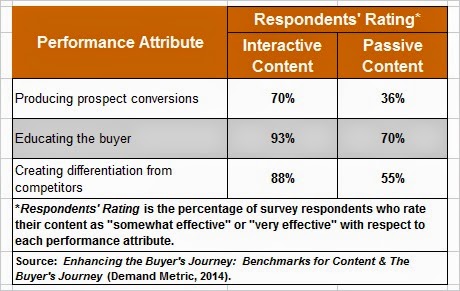- 86% of survey respondents said their companies are using content marketing.
- 70% of respondents said they are producing more content than they did one year ago.
- 55% of respondents said they plan to increase or significantly increase their content marketing spending.
When it's done correctly, content marketing is the most effective way to create meaningful engagement with today's empowered and independent buyers. However, I suggest that we are beginning to see signs of content fatigue. The irony is that the growing popularity of content marketing is contributing to content fatigue and creating a new challenge for marketers. As more and more companies publish more and more content, it's becoming more difficult to make your content stand out.
Of course, the need to create content that captures the attention of prospects and triggers engagement is not new. In all five of the annual content marketing surveys by CMI/MarketingProfs, producing engaging content has been one of the three top challenges identified by survey respondents. The explosive proliferation of content and the resulting content fatigue have only added to the challenge.
Recent research by Demand Metric reveals that interactive content can be a powerful weapon for combating content fatigue. In the Demand Metric study, interactive content was defined as content that invites or requires some level of active involvement by the prospect. The survey provided study participants several examples of interactive content, including wizards, configurators, assessments, quizzes, calculators, and games. Passive content was defined as content that invites or requires little or no interaction by the prospect beyond reading, viewing, or listening.
Demand Metric asked study participants to categorize their content using one of five options - very passive, somewhat passive, moderate, slightly interactive, or very interactive. Then, Demand Metric grouped the responses into two broader categories. The passive content category included the "very passive," "somewhat passive," and "moderate" responses, while the interactive content category included the "slightly interactive" and "very interactive" responses.
Next, Demand Metric asked survey participants to rate the effectiveness of their content at performing three critical marketing functions - producing prospect conversions, educating the buyer, and creating differentiation from competitors. Finally, Demand Metric compared the ratings of interactive content users with passive content users.
The table below shows the results of this comparison, and the results demonstrate clearly that interactive content is better than passive content at performing all three vital marketing functions.
The use of interactive content is not new. Some companies, primarily larger enterprises, have been using configurators, assessments, and calculators for several years. But, the interest in interactive content is growing rapidly, and the technology required to produce interactive content at scale is becoming more affordable. Therefore, the next major phase in the evolution of content marketing may well be the marketing app.





No comments:
Post a Comment